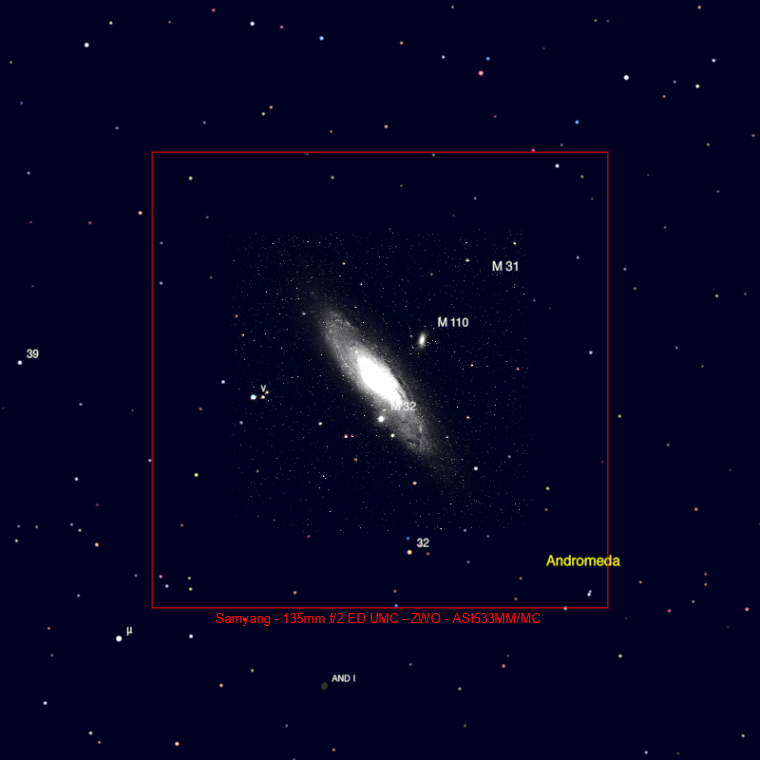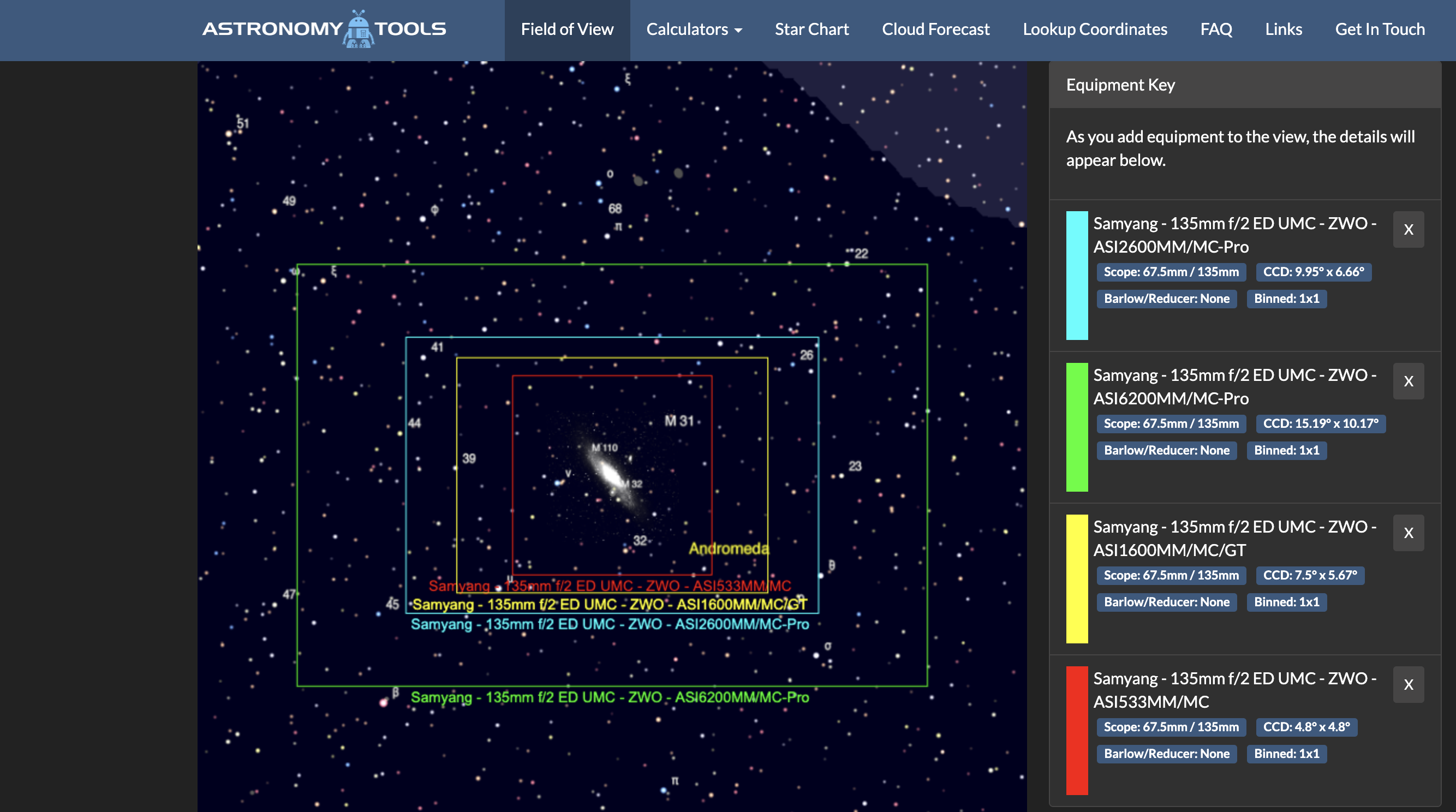Any experienced users have opinions/example images (masters or finished image)?
Does the 533mm Pro pair well with Samyang 135 and 3nm narrowband filters?
11 replies•402 views
I used this Combination to shoot the veil nebula recently https://astrob.in/fb59rf/0/. I did notice some out of roundness in the corners but i never worked out if it was just tilt or if it was in fact the lens. blur exterminator took care of it regardless.
This is basically the same as the 2600mm and I have had and used both with this lens. I have used both 3nm and 4.5nm filters as well as broadband. Something to consider about 3nm Ha is the exclusion of Hbeta. Some NB examples:
Not done with the Samyang, but the Nikkor AI 135mm F/2.8 using the 533MM, 4.5nm Ha & 3nm Oiii/Sii: https://www.astrobin.com/nvkfa6
ASI533MM, Samyang 135mm, 4.5nm Ha - This was purely a backfocus testing image i made: https://www.astrobin.com/1ds9r7/0/
ASI533MM, Samyang 135mm, 4.5nm Ha, 3nm Oiii: https://www.astrobin.com/rnsy4e/
ASI2600MM, Samyang 135mm, 3nm Oiii/Ha: https://www.astrobin.com/p5xcmy/M/
3nm filters will work just fine, but I would perhaps consider 4.5nm to include Hbeta as well. If you intend to shoot at F/2 you would be better off with ones made for fast optics.
Not getting an entire field of round stars, and slightly off nebulosity like seen in my test image, is very common even on smaller sensors. This is purely down to tilt/backfocus which is crucial at those F-Ratios, each fraction of backfocus matters a lot. So spend some time adding 0.1mm spacers to the image train in order to evaluate the stars. An easier option would be to stop down slightly, which perhaps is necessary on certain copies due to poor QC.
What I found to work for me was to try and get the backfocus as best as possible so that the stars were workable, then I just spend a few minutes re-shooting them slightly stopped down to F/2.8 or F/4. I've got some step down rings for that purpose now.
Not done with the Samyang, but the Nikkor AI 135mm F/2.8 using the 533MM, 4.5nm Ha & 3nm Oiii/Sii: https://www.astrobin.com/nvkfa6
ASI533MM, Samyang 135mm, 4.5nm Ha - This was purely a backfocus testing image i made: https://www.astrobin.com/1ds9r7/0/
ASI533MM, Samyang 135mm, 4.5nm Ha, 3nm Oiii: https://www.astrobin.com/rnsy4e/
ASI2600MM, Samyang 135mm, 3nm Oiii/Ha: https://www.astrobin.com/p5xcmy/M/
3nm filters will work just fine, but I would perhaps consider 4.5nm to include Hbeta as well. If you intend to shoot at F/2 you would be better off with ones made for fast optics.
Not getting an entire field of round stars, and slightly off nebulosity like seen in my test image, is very common even on smaller sensors. This is purely down to tilt/backfocus which is crucial at those F-Ratios, each fraction of backfocus matters a lot. So spend some time adding 0.1mm spacers to the image train in order to evaluate the stars. An easier option would be to stop down slightly, which perhaps is necessary on certain copies due to poor QC.
What I found to work for me was to try and get the backfocus as best as possible so that the stars were workable, then I just spend a few minutes re-shooting them slightly stopped down to F/2.8 or F/4. I've got some step down rings for that purpose now.
Helpful Insightful
andrea tasselli Frequent contributor
Sep 18, 2024
Jan Erik Vallestad:
This is basically the same as the 2600mm and I have had and used both with this lens. I have used both 3nm and 4.5nm filters as well as broadband. Something to consider about 3nm Ha is the exclusion of Hbeta
There is no such a thing. The Balmer sequence is Ha - Hb - Hg... and the visbile light frequencies of the series are:
656.3
486.1
434.0
410.2
397.0
So maybe you are referring to an OIII filter but that needs to be much wider then 4.5nm to include both the two emission lines of OIII and Hb.
Concise
andrea tasselli:
So maybe you are referring to an OIII filter but that needs to be much wider then 4.5nm to include both the two emission lines of OIII and Hb.
Yes, thanks for correcting me. It went a bit fast and I unconsciously swapped Hb for Nii which is excluded with 3nm but included in both 4.5nm and 5nm.
andrea tasselli Frequent contributor
Sep 18, 2024
Nearly 25 square degree of sky, seems pretty extensive to me...


Any experienced users have opinions/example images (masters or finished image)?
The Samyang 135 pairs very well with 533mm Pro. You will find many examples on my site.
However I use 6.5nm high speed narrowband filter as I image at f2.
https://www.astrobin.com/g4zej6/?nc=collection&nce=31225
https://www.astrobin.com/axqg8y/?nc=collection&nce=31225
https://www.astrobin.com/mujxll/?nc=collection&nce=31225
https://www.astrobin.com/6cjpz2/?nc=collection&nce=31225
I wouldn’t recommend this combination. The Samyang is very wide for deep sky imaging, but the 533 is small sensor. For a wide view you want a wide sensor. A full frame or APSC size chip would be a much better pairing. The field of view of your image will be cropped 2.7x compared to a full frame sensor, which that lens supports.
Well Written Helpful Insightful Concise
